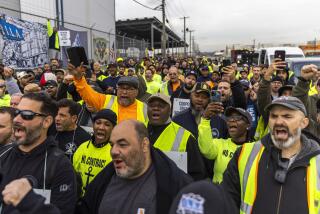THE EASTERN BANKRUPTCY : Trouble for Miami : Strike Puts Drag on Already Tepid Local Economy, at Least for a While
- Share via
MIAMI — The tailspin of Eastern Airlines is likely to leave this city in a spin of its own that could empty pockets by more than $1 billion in the next year, some economists here predict.
Even recently, as Eastern scaled down its size, the airline was Miami’s largest private employer. It had 10,000 local workers--most of them now laid off or on strike. It paid $500 million in wages and benefits in the three-county area known as South Florida.
Loss of those paychecks will tighten belts. There will be less to spend in grocery stores and shopping malls and auto showrooms. There will be a ripple of bad tidings that will bring more layoffs.
“Some of the Eastern people will find jobs in the area, but not jobs that pay what they were making at the airline,” said Guillermo Grenier of the Center for Labor Research and Studies at Florida International University.
The impact of Eastern’s move toward bankruptcy flattens out the growth of an economy already gone sluggish. “We didn’t have much momentum going into 1989, anyway,” said J. Antonio Villamil, chief economist for Southeast Bank.
“We finished 1988 with 2% employment growth, about half the rate of Florida in general. Construction activity was down because of the overbuilding of strip shopping centers and office buildings.”
There are other problems as well. This is a tourist town. Publicity about racial violence and a new influx of refugees will not lure sunbathers.
Uncertainty in Venezuela also hurts. That nation is South Florida’s largest foreign trading partner, purchasing $1.5 billion in goods and services. “We’ll see a 15% decline in that,” Villamil said.
These dreary forecasts, however, are purely for the short term. South Florida has a $50-billion economy. Miami is not a company town. Unemployment is only 6.2%. Businesses continue to relocate here.
“Six to eight months, the effects of Eastern may be history--no noticeable effects,” said Pat Fishe, an economist at the University of Miami.
That may be optimistic. Much depends, of course, on how long it takes the airline to reorganize--or other airlines to take its place.
Some Eastern employees surely will find work in the industry. There is a need for pilots, though many will have to relocate. Others, such as reservation clerks, have computer skills transferable to other businesses.
Machinists may have the most difficult time. “They can’t go to work in auto repair shops and make $18 an hour,” said Grenier, of Florida International. “If they stay around here, they’ll take quite a cut.”
However things sort out, some businesses already feel a pinch. Those most apt to notice are the ones near Miami International Airport, where many Eastern employees live, in suburbs such as Miami Springs.
“I had to lay off some employees,” said Bill Behel of Field Shops, which supplies uniforms to airline workers.
Pedro Hidalgo, owner of Eldorado Jewelers and Repairs, said half his customers came from Eastern. This past week, he has not been able to make the $100 a day his business needs to survive.
“People are going back to basics: rent, light, food,” he said.
Jack Dewhurst, the mayor of Miami Springs, said things have begun to slow down at his auto repair shop.
“I suppose you’ll see a lot of ‘for sale’ signs going up on the lawns,” he said. “There will be some bargains.”
More to Read
Sign up for Essential California
The most important California stories and recommendations in your inbox every morning.
You may occasionally receive promotional content from the Los Angeles Times.












